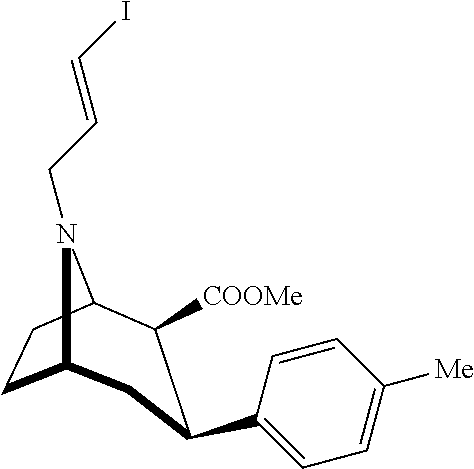Labeled pe2i formulation and method
a technology of pe2i and formulation, applied in the field of medicine, can solve the problems of high misdiagnosis and non-diagnosis rate, no available test that can clearly identify, unpredictable radiochemical and chemical stability of each uniquely structured radio-labeled entity, etc., and achieve the effect of facilitating therapy directed
- Summary
- Abstract
- Description
- Claims
- Application Information
AI Technical Summary
Benefits of technology
Problems solved by technology
Method used
Image
Examples
example 1
Synthesis of [123I]-N-(3-iodoprop-2E-enyl)-2β-carbomethoxy-3β-(4-methylphenyl)nortropane
[0054]Sodium [123I]-iodide (4 Ci) in 0.1N NaOH is dispensed in a 10 mL vial and heated to about 80° C. Phosphate buffer, 0.80 mL 0.1 M, pH 2.5-3.0, is combined with 0.20 mL 30% hydrogen peroxide, and 0.50 mL of 1 mg / mL (in ethanol) N-(3-tributyltin-2E-propenyl)-2β-carbomethoxy-3β-(4-methylphenyl)nortropane to form a precursor containing mixture. The sodium [123I]-iodide solution is acidified (final pH123I]-iodide solution. The mixture is heated at 80° C. for 15 minutes.
[0055]After 15 minutes, 2 mL of sodium metabisulfite solution is added to stop the reaction (100 mg / mL in Sterile Water for Injection). One mL of a 100 mg / mL solution of Ascorbic Acid is added to the reaction mixture as a radioprotectant. The acidic reaction mixture is optionally neutralized with 500 μL of 5 N Sodium Hydroxide. After neutralization, the pH is >6. Neutralization may be optional if the subsequent HPLC system is not d...
example 2
Chromatography of [123I]-N-(3-iodoprop-2E-enyl)-2β-carbomethoxy-3β-(4-methylphenyl)nortropane
[0056]The reaction mixture of Example 1 is transferred to a preparative HPLC system (XTerra® C18 Column from Waters Corp., Milford, Mass., see U.S. Pat. No. 6,686,035).
XTerra® Column
Packing Material: C-18
Particle Size: 5 μm
Length: 50 mm
Diameter: 10 mm
Column Volume: 4 mL
[0057][123I]-N-(3-iodoprop-2E-enyl)-2β-carbomethoxy-3β-(4-methylphenyl)nortropane is eluted using the following eluent system: isocratic elution buffer, 15% (v / v) ethanol, 85% 10 mM glacial acetic acid in sterile water for injection. The product peak is collected into a vessel containing sodium chloride injection (USP) in an acetic acid buffer pH 2.5 to 3.5, and, due to carry over, the final solution has about 1.8% ethanol. Noted is the fact that in particular embodiments, the product comprises an aqueous solution comprising 0.1-5 mCi / mL, at the time of production, [123I]N-(3-iodoprop-2E-enyl)-2β-carbomethoxy-3β-(4-methylpheny...
example 3
Chromatography of [123I]-N-(3-iodoprop-2E-enyl)-2β-carbomethoxy-3β-(4-methylphenyl)nortropane
[0059]The reaction mixture of Example 1 is transferred to a preparative HPLC system (μBondpak® C18 Column from Waters Corp., Milford, Mass.).
μBondpak Column
Packing Material: C-18
Particle Size: 10 μm
Length: 300 mm
Diameter: 19 mm
Column Volume: 85 mL
[0060][123I]-N-(3-iodoprop-2E-enyl)-2β-carbomethoxy-3β-(4-methylphenyl)nortropane is eluted using the following eluent system: isocratic elution buffer, 80% (v / v) ethanol, 20% ascorbic acid in sterile water for injection 20 g / L. The product peak is collected into a vessel containing sodium chloride injection (USP) in an acetic acid buffer pH 2.5 to 3.5. Due to carry over the final solution has about 3.8 to about 6.3% ethanol and about 0.2 to about 0.4 g / L ascorbic acid. The resulting radioactive concentration of [123I]-N-(3-iodoprop-2E-enyl)-2β-carbomethoxy-3β-(4-methylphenyl)nortropane is about 5 mCi / mL of solution.
PUM
| Property | Measurement | Unit |
|---|---|---|
| Temperature | aaaaa | aaaaa |
| Temperature | aaaaa | aaaaa |
| Temperature | aaaaa | aaaaa |
Abstract
Description
Claims
Application Information
 Login to View More
Login to View More - R&D
- Intellectual Property
- Life Sciences
- Materials
- Tech Scout
- Unparalleled Data Quality
- Higher Quality Content
- 60% Fewer Hallucinations
Browse by: Latest US Patents, China's latest patents, Technical Efficacy Thesaurus, Application Domain, Technology Topic, Popular Technical Reports.
© 2025 PatSnap. All rights reserved.Legal|Privacy policy|Modern Slavery Act Transparency Statement|Sitemap|About US| Contact US: help@patsnap.com

